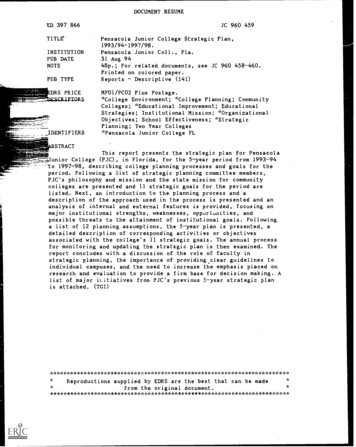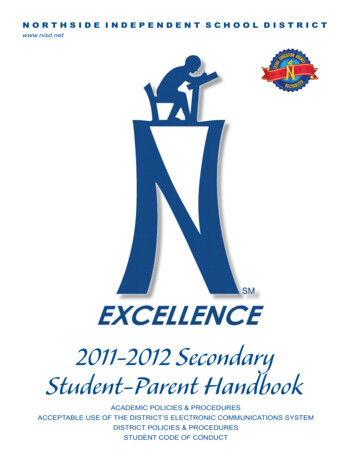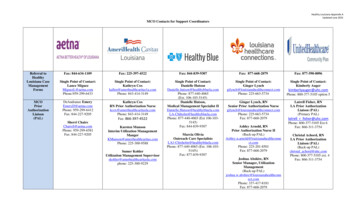
Transcription
DOCUMENT RESUMEED 397 866TITLE'INSTITUTIONPUB DATENOTEPUB TYPEDRS PRICERIMSIDENTIFIERSJC 960 459Pensacola Junior College Strategic Plan,1993/94-1997/98.Pensacola Junior Coll., Fla.31 Aug 9448p.; For related documents, see JC 960 458-460.Printed on colored paper.ReportsDescriptive (141)MF01/PCO2 Plus Postage.*College Environment; *College Planning; CommunityColleges; *Educational Improvement; EducationalStrategies; Institutional Mission; *OrganizationalObjectives; School Effectiveness; *StrategicPlanning; Two Year Colleges*Pensacola Junior College FLSTRACT,This report presents the strategic plan for PensacolaJunior College (PJC), in Florida, for the 5-year period from 1993-94-to 1997-98, describing college planning processes and goals for theperiod. Following a list of strategic planning committee members,PJC's philosophy and mission and the state mission for communitycolleges are presented and 11 strategic goals for the period arelisted. Next, an introduction to the planning process and adescription of the approach used in the process is presented and ananalysis of internal and external features is provided, focusing onmajor institutional strengths, weaknesses, opportunities, andpossible threats to the attainment of institutional goals. Followinga list of 12 planning assumptions, the 5-year plan is presented, adetailed description of corresponding activities or objectivesassociated with the college's 11 strategic goals. The annual processfor monitoring and updating the strategic plan is then examined. Thereport concludes with a discussion of the role of faculty instrategic planning, the importance of providing.clear guidelines toindividual campuses, and the need to increase the emphasis placed onresearch and evaluation to provide a firm base for decision making. Alist of major iLitiatives from PJC's previous 5-year strategic planis attached. ***************************Reproductions supplied by EDRS are the best that can be madefrom the original ******************************
PENSACOLA JUNIOR COLLEGESTRATEGIC PLAN1993/94 - 1997/98U.S. DEPARTMENT OF EDUCATIONOrrice or Er:ma what Research and imph.wementEDUCATIONAL RESOURCES INFORMATIONCENTER (ERIC)This Jocum ent has been reproduced as.X.rec Ned from the person or organizationoriginating it0 Minor changes have been made toimprove reproduction quality-------PERMISSION TO REPRODUCE ANDDISSEMINATE THIS MATERIALHAS BEEN GRANTED BYM.W. McLeod-Points of view or opinions stated in thisdocument do not necessarily representofficial OERI position or policyTO THE EDUCATIONAL RESOURCESINFORMATION CENTER (ERIC)Approved by:Dr. Horace E. HartsellPresidenteming, ChairpersonDistrict Board of TrusteesAugust 31 , 1994Date2BEST COPY AVAILABLE1
PENSACOLA JUNIOR COLLEGESTRATEGIC PLAN1993/94 - 1997/983
TABLE OF CONTENTS1993/94 - 1997/98PageI.II.III.IV.V.VI.Strategic Planning Committee - 1992-931Philosophy and Mission of PensacolaJunior College2Strategic Goals (1992193-1997198)4Introduction:The Planning.Process5The Approach6Internal and External ties15Threats (Concerns)16Planning Assumptions17The Plan19IX.X.XI,XII.Goal 1Goal 2Goal 3Goal 4Goal 5Goal 6Goal 7Goal 8Goal 9Goal 10XIII.XIV.XV.21232427283031363840Process for Monitoring and Updatingthe Strategic District Plan41Conclusion42A List of Major Initiatives fromthe Last 5-Year Strategic Plan44
STRATEGIC PLANNING COMMITTEE1992-1993Dr.Dr.Dr.Mr.Dr.H. E. HartsellCharles AtwellRichard BedicsEarl BerryJames Blackwell, ChairmanDr. Isaac BrighamDr.Dr.Ms.Dr.James CaruthersDenton CokerJackie EdwardsBdn FindleyMs. Edith FoxDr. Martin GonzalezMr. Tom HeffernanDr. Aaron JamesrMs. Janet LevinsMx. Ned MayoDr. Marshall McLeodMs. Margie MooreMs. Carolyn PhillipsDr.Ms.Dr.Dr.Dr.Donn PeerySharon PittsBetsy SmithRod SmithAnn SoutherlandDr. Rand SpiwakMr. David SuttonDr. Jill WhiteMs. Sharon WilliamsMs. Courtney WinsteadMr. Darryl WiseDr. Doug WorleyPresidentExecutive Vice PresidentProvost, Pensacola CampusFaculty RepresentativeVice President for Planningand Administration.Associate Vice President ofStudent AffairsResource DevelopmentDistrict Board of Trustees MemberCareer Service RepresentativeDirector, Human ResourcesManagementCareer Service RepresentativeDepartment Head, BusinessDirector, Maintenance and PlantOperationsDepartment Head, Business, ComputerScience and Related Technologies,Warrington CampusFaculty RepresentativeFaculty RepresentativeDirector, Institutional Researchand EffectivenessCommunity RepresentativeExecutive Director, Information andTelecommunications SystemsProvost, Community ProgramsCareer Service RepresentativeProvost, Warrington CampusFaculty RepresentativeDistrict Dean of VocationalEducation/SPDVice President, Business AffairsCoordinator, Military ProgramsAssociate Vice President forCurriculum and InstructionCareer Service RepresentativeStudent Services Director,Warrington CampusStudent RepresentativeProvost, Milton Campus5
PHILOSOPHY AND MISSIONOFPENSACOLA JUNIOR COLLEGEPhilosophyis a student-centered, comprehensivecommunity college dedicated to providing educational opportunitiesthat develop the personal, academic, career, and aestheticcapabilities of individuals so that they may achieve selffulfillment and participate fully and positively in a democraticsociety.Pensacola Junior CollegeFurthermore, the College promotes lifelong learning to meet thechallenges of a changing world, strives for equity in access and inthe learning process for each individual regardless of race, sex,religion, age, or disability, and provides quality educationalprograms and services that embrace high academic standards. Beingthe College exercisesfiscaldccountable to its citizens,responsibility manifested by offering services and programs at thelowest possible cost to support the concept of an open doorinstitution.Pensacola JuLior College, as a comprehensive community college,must be many :hings to many people and must serve the diverse needsof the community now and into an increasingly complex world of thefuture.MissionThe mission of Pensacola Junior College is to provide educationalopportunities to meet the diverse requirements of all students inpreparing for, and continuing with, lifetime education in careertraining and intellectual fulfillment. College credit courses andAssociate of Arts degree programs at the freshman and sophomorelevels prepare students for entry at the university junior level.Associate of Science degree programs and vocational certificateprograms are offered to students in technical areas to train forCommunitycareer entry and for limited transfer opportunities.services, courses, and programs in continuing education supplyindividuals and groups with particular needs and interests, whethercredit or non-credit, as a lifelong learning endeavor.The College serves those students not prepared to enter collegelevel progzams by providing adult basic education programs,Thedevelopmental programs, and adult high school programs.2
economic development of the service area is supported throughtraining and retraining activities in an attempt to attract newFinally, the Collegeindustry and expand existing industry.center for cultural,aathleticactivities for therecreational, leisure, health, andfulfillsacommitmenttoasserveenrichment of the students and citizens of Escambia and Santa Rosacounties.37
STATE MISSION FOR COMMUNITY COLLEGESThe following mission statement for community colleges is taken from Chapter 91-55, Section240.301 of the Florida Statutes:State community colleges shall consist of all public educational institutions operated bycommunity college district boards of trustees under statutory authority and rules of the StateBoard of Education and the State Board of Community Colleges. A community college may beauthorized by the State Board of Education to operate a department designated as an arcavocational education school. A community college may be authorized by the State Board otEducation, or through an agreement with a local school board, to be the designated provider inthe service district of adult education services, including adult basic education, adult generaleducation, adult secondary education, and general educational development test instruction. Thestate community colleges are locally based and governed entities with statutory and funding tiesto state government. As such, the community colleges' mission reflects a commitment to beresponsive to local educational needs and challenges. In achieving this mission, the collegesstrive to maintain sufficient local authority, and flexibility while preserving appropriate legalaccountability to the state.(1)As comprehensive institutions, the community colleges shall provide high quality,affordable education and training opportunities, shall foster a climate of excellence, and shall(2)provide opportunities to all while combining high standards with an open-door admission policy.The community colleges shall, as open-access institutions, serve all who can benefit, withoutregard to age, race, gender, creed, or ethnic or economic background, while emphasizing theachievement of social and educational equity so that all can be prepared for full participation insociety.The primary mission and responsibility of public community colleges is responding tocommunity needs for postsecondary academic education and postsecondary vocational education.This mission and responsibility includes being responsible for:(3)(a)Providing lower level undergraduate instruction and awarding associate degrees.(b)Preparing students directly for vocations requiring less than baccalaureate degrees.This may include preparing for job entry, supplementing of skills and knowledge, andresponding to needs in new areas of technology. Vocational education in the community collegeshall consist of postsecondary adult vocational programs leading to certificates, credit coursesleading to an associate in science degrees, and other programs in fields requiring substantialacademic work, background, or qualifications. A community college may offer vocationalprograms in fields having lesser academic or. technical requirements if it is designated by theState Board of Education as an area vocational school or if such programs are coordinated withthe local school district through an agreement with the school board.
Providing student development services, including assessment, student tracking,(c)support for disabled students, advisement, counseling, financial aid, career development, andremedial and tutorial services, to ensure student success.Promoting economic development for the state within each community collegedistrict through the provision of special programs, including, but not limited to, the:(d)1.2.3.4.(4)in:Enterprise Florida related programsTechnology transfer centers.Economic development centers.Work force literacy programs.A separate and secondary role for community colleges includes the offering of programs(a)Community services which are not directly related to academic or occupationaladvancement.(5)(b)Adult precollege education, when authorized.(c)Recreational and Leisure services.Funding for community colleges shall reflect their mission as follows:(a)Postsecondary academic and postc.r.ondary vocational education programs and,when assigned to community college, adult precollege education programs shall have firstpriority in community college funding.Community service programs shall be presented to the Legislature with rationale(b)for state funding. The Legislature may identify priority areas for use of these funds.Community colleges are authorized to offer such programs and courses as arenecessary to fulfill their mission and are authorized to grant associate in arts degrees,associate in science degrees, associate in applied science degrees, certificates, awards, anddiplomas. Each community college is also authorized to make provisions for the generaleducational development examination.(6).9
THE PJC STRATEGIC PLAN GOALS(1993/94 - 1997/98)During the next five-year period, the theme for strategic planning at Pensacola Junior College isthe continuous improvement of the college by illustrating substantial progress toward fulfillingthe following strategic goals:I.To improve each student's academic development afid achievement from point of initialcontact through completion of each individual's educational goal(s).2.To improve the financial status of the College through expansion of funds from state andother sources and by more effective use of the financial resources on a College-wide basis.3.To improve educational programs in order to enhance educational excellence.4.To improve community relationships by continuing to serve educational, cultural, andrecreational needs of the citizens of the district.5.To improve communication with internal constituencies.6.To improve governance of the institution by initiating a shared management approachwhich uses student and employee input in developing the leadership and vision needed toaddress college issues. This includes improving planning data and institutional research tosupport the shared management initiative.7.To improve the effectiveness and efficiency of PJC operations through application of theresults obtained from the systematic evaluation of programs, services, personnel, andfacilities.8.To improve salaries, fringe benefits, working conditions, profes'iional development, andcareer mobility of the institution's human resources.9.To improve student services and student support activities which assist in meeting thesocial, cultural, career development, and recreational needs of each individual student.10.To improve communication with external constituents (business, industry) in order toprovide more effective and efficient job training and upgrading of on-the-job skills toenhance the economic development of the district.11.Strengthen the utilization of technology to support contemporary standards and futureapplications in academic computing technologies, administrative computing systems, andeducational telecommunications.4.10
INTRODUCTION:THE PLANNING PROCESSIn 1985, Pensacola Junior College began a major strategicplanning effort designed to develop a new five-year plan for theJunior College district, including three campus locations at thattime,and to continue planning asdecision making process.part ofthe institution'sThe Strategic Plan became effective in1987 and covered the period through 1992.The Plan proved quitesuccessful in keeping strategic issues at the forefront of theinstitution's efforts to achieve excellence in its many endeavors.With the close of the five-year period, a new Strategic PlanningCommittee convened to begin the process of meeting new challengesand charting new directions for the institution in the next fiveyear period (1993/94 - 1997/98).This activity is designed to be on-going.Annual evaluationsof the progress in attaining institutional goals will be monitoredand documented.The implementation of the Plan over the next fiveyears will require the involvement of the total College community.Systematic dedication of fiscal resources will be required tosupport each activity.The continued and successful life of theCollege depends on every individual faculty member, administrator,professional and career service member supporting the premise thatstudent success is at the heart of each of the goal statements andthat the activities which have been chosen will be the focus toguide the College's efforts during the planning period.5ii
THE dministration convened the Strategic Planning Committee.andTheCommittee consisted of 31 individuals representing all areas of theCollege's functional units; one member of the District Board ofTrustees, one student, and one community representative.The group began its deliberations with the adoption of a themeof "continuous improvement over the next five-year period within amademore shared governance structure." A review of the progressin fulfilling the goals from the last five-year Plan was theninitiated.75%It was conservatively estimated that approximatelyof the Plan had been achieved during the previous five years.The first task attempted by the Committee was a revision ofAfter much deliberation, thethe College's mission statement.by theformer mission statement was modified and approvedCommittee.It appears on page 2.A determination was made to keep the planning model used forthe previous cycle, an institutional analysis employing the SWOTThesemodel (Strengths, Weaknesses, Opportunities, Threats).characteristics were examined in depth, some were deleted as echaracteristics were added as a result of environmental changesWeekly meetings were held toover the last five-year period.discuss, analyze, and seek consensus agreement on this analysis.A ranking system applied to the individual items resulted in the612
selection of the five most important items in each of the SWOTcategories.The next task to be undertaken by the Committee was to makecertain azqumptions about internal and external demographics whichcould influence the planning process.Again, the previous Planassumptions were reviewed, modified, discarded, and new assumptionsadded.These are included in the document on page 9.Using thesedata as well as other considerations, ten strategic goals wereidentified to guide the College's major initiatives for the nextfive years.Eight of the existing goals were reworked; two newgoals were added.The goal statements have been adopted by thePresident's Council, which is the internal governance unit for theinstitution, and the District Board of Trustees.After establishing the ten goals, the larger Committee wasbroken into sub-groups to devise the activities(objectives) bywhich the goal statements could be achieved.Three Committeemembers were assigned to each of the ten goals with the directionthat they include three or more additional representatives from theCollege community that were not members of the larger Committee.This provided a great deal more input than did the previousplanning process. These activities, with assigned responsibilitiesand time lines for beginning and completing, were more specific andconstituted the vehicles for goal attainment.The Vice Presidentfor Planning and Administration was given the responsibility forevaluating progress annually and for providing the leadership toconvene the Strategic Planning Committee to review progress toward713
goal achievement as well as updating the Plan as environmentalconditions change.The projected date for completion of the Planwas May 31, 1993.Implementation of the Plan will begin July 1,1993.814
INTERNAL AND EXTERNAL ANALYSISSTRENGTHSThe Strategic Planning Committee began its task of devising anew strategic plan by reviewing what the members felt to be themajor assets of PJC from the 1987 document.The process employedwas a dynamic group interaction, one which was open to each member.Anyone could make suggestions but Had to justify them.By groupconsensus, twenty-five strengths were eventually identified.determine the relative importance of the strengthsToidentified,members of the Committee were asked to independently rank eachstrength.The results of the ranking procedure for the five mostimportant ones are indicated on page 12.The underlying assumption of this process was the hsshouldbe',capitalized upon and objectives written to further expand and,improve already valuable assets of the institution.Four of thestrategic goals (I, III, IV, VIII) relate directly to the five mostimportant strengths of the institution.WEAKNESSESIt wouid be a distorted view of an institution's well-being ifits members did not recognize the imperfections in the institutionas well as the strengths.By a similar process, the StrategicPlanning Committee developed a list of perceived weaknesses andAll five of these weaknesses areranked the most important five.915
In fact, ofaddressed by one or more of the strategic goals.nineteen weaknesses identified, most are addressed through the tenstrategic goals adopted in directing the institution toward theyear 2000.It should be obvious that the planning process wouldneed to address all recognized weaknesses.The list of weaknessesand the ranking of the five most important are found on page 14.OPPORTUNITIESAnalysis of bath strengths and weaknesses focused on theinternal environment at PJC.purposeofenvironment.by thereactingandA community college exists for theinteracting also withitsexternalA review of the external environment was undertakenStrategicPlanning Committeefrom thestandpointofopportunities existing in the service area which had not beenaddressed before or which needed to be addressed.Fifteenstatements were generated describing areas of new effort to whichthe institution might direct itself in thecoming yearsordescribing efforts which were on-going but needed improving.Again, the five most important opportunities as perceived by theCommittee were ranked.Virtually every opportunity identified hasbeen addressed in the goal and objective statements.The list ofopportunities and the ranking of the five most important are foundon page 15.1016
THREATS (CONCERNS)In any given situation,forces are present which impedeprogress toward goals or prevent agencies from accomplishing theirmissions to the fullest extent possible.The Committee identifiedfifteen of these deterrents to progress as a result of the reviewprocess.In most cases, the institution has no direct control overthese forces but must be cognizant they are present or will bepresent in the future.these factors.For this reason, none of the goals addressBy initiating action in all other areas of theplanning process, the institution hopes to minimize the effect ofthese negative forces by being aware and being able to devisestrategies to combat sudden shifts in the external environment.These external threats are identified on page 16.11117
STRENGTHS-skills,attitudes,credentials,1College Personnelcommitment4Student achievement5Positive image the College has with students, employees,and communityUse of Financial Resources2Diversity and flexibility of services and programsPhysical appearance of campusesEducational facilities (buildings)AdequacyQuality3Accessibility - openness, multi-campus, centersPhysical working conditions for faculty and staffFaculty and staff developmentUse of the computer in administrative applicationsLocal Board of Trustees - commitment, relationships withcommunity and College staffPublic educational television - linkages with communityand to public educational entities in the nistrators at local, state, and national levelsCollege working relationships with area public schools,other colleges and universitiesCommitment and support of equal access/equal opportunityfor all citizensemphasis throughoutcentered""Studentorganizational structure of the CollegetheentireCommunication about activities and events at the CollegeInstructional support - library, audiovisual equipment,etc.1218
PJC Foundation - accomplishments in supporting Collegeprograms and activitiesQuick and effective response to community needsStudent Financial Aid ProgramCurriculum administration - planning, design, system nstitutional mission effectively with a minimum ofpersonnelPlacement and follow-up of students1319
WEAKNESSESInternal Communication2External CommunicationRelationship with Faculty UnionInadequate (number) administrative and support staffingInadequate (number) faculty staffingAcademic transfer to UWFProgram to program articulation with UWFLack of school spiritEvening program (few full-time faculty; support services)Purchasing process (cumbersome and time problems)andRecruitmentspecialized areas1retentionofinfacultycertainInadequate salaries (Faculty, Staff, Admin.)Institutional research(organizationalstructure andstaffing)4Retention of studentsAdvising process for studentsAdequate and timely management informationInstitutional evaluation3Integration of technology in classes and labs5Lack of sufficient standardization of academicstudent affairs, and other issues among campuses14and
OPPORTUNITIES1Training for business and industryLiteracy trainingMilitary involvement4Influencing local, state, and federal agencies to addresscommunity college concerns5Financial support from the community (endowed chairs,scholarships, equipment, etc.)Continuing education3Linkages with K-12, upper level institutions.International education programsDevelop and market discrete areas of academic excellencedisabled,Meet needs of special population groups:minority, single parent, economically disadvantaged2Development and delivery of non-traditional methods ofinstructionCooperative education programsUse of media to support and enhance PJCLocate and solicit federal dollars ay befederalDevelop a Total Quality Management program of continuousimprovement1521
THREATS (CONCERNS)Slower recovery of5state and national economy thanpredictedCompetition with local and other upper level institutionsfor student enrollments and dollarsLoss of local control and increase of financial pressuresbrought about by actions of agencies like:1a.b.c.d.e.f.PEPCState Board of Community CollegesLegislature (legislative agencies)State Board of EducationGrowth Management agenciesLocal cost-containing efforts by local organizationsContinued lack of qualified faculty in certain areas (andthe ability to hire at our salary levels if located)4Overall competition for federal and state dollarsNegative perceptions about administrative organizationsby the general publicConservative move in state governmentStudent increase in tuition beyond a point at whichstudents can afford to enrollAttrition and retention of qualified faculty sessment,(costsandAmericansforevaluationRmployee benefits (increasing cost)Escalating legal costs and liabilityCrime, safety, health, personal.securitycostsIncreasingDisabilities Act2associatedwithIncrease in number of underprepared students with theattendant costs in assessment, support, and followthrough services16
PLANNING ASSUMPTIONSPopulation Demographics -1.By the year 2000:The population of Escambia County will increase 7%.*The population of Santa Rosa County will increase21.4%.The number of high school graduates will increase.The percentage of the district population over 55will increase 31.9%.The minority portion of the Escambia County populationwill increase 7.5%.The minority portion of the Santa Rosa Countypopulation will increase by 4.5%.The disabled percentage of the district populationwill remain at current levels.The military portion of the population will likelyincrease.2.Unemployment in the two counties will range from 5.5% to7.5% and will continue to be higher among minorities andyouth.3.Inflation will range between 3% and 5% annually.4.Relative delines in the service area employment willoccur in the following sectors:FarmersAppliance RepairsTelephone Repairers/InstallersTextile Machine OperatorsCentral Office OperatorsChemical Equipment Operators5.Relative increases in the service area employment willoccur in the following sectors:Home Health AidesNursing Aides and OrderliesRegisteredNpurses1723.
LPN'sCooksFood Service and Lodging Managers6.Public attention to the quality of education at alllevels will continue. All educational institutions eness.7.More high school students will demand early iversities will raise their admission standards,particularly in a number of restrictive programs.8.There will be increased competition for students betweenPJC and UWF.9.There will be increasing administrative and financialburdens on the College as a result of the activities ofregulating agencies.10.Federal financial aid will continue at current or lowerlevels.11.State aid to education may not improve drastically;students will bear a greater part of their educationalexpenses.12.Salary increases in the private sector and in otherpublic sectors may make it difficult to hire qualityemployees.* Population ProgramBureau of Economics and Business ResearchCollege of Business AdministrationUniversity of FloridaGainesville, Florida 32611-20171824
THE PLANThefive-yeargoalsdevelopedthroughstrategic and subject to annual reevaluation.thisprocessareThe Plan does notattempt to spell out at this point every objective by which eachInstead, the Plangoal will be achieved over the next five years.outlines critical major objectives that have been established inresponse to the important issues 'and problems discovered as aresult of the internal and external assessments.The Plan shouldbe viewed as a framework for decision making and development of theinstitution, not to restrict other activities from taking placewhich may be important in themselves in Lmproving the institution.Therefore, while the goals will remain relatively constantover the next five years, the strategies employed to accomplishthem willThechange with circumstances and opportunities.processes for updating and monitoring the Plan outlined in thisdocument earlier assure that the District Strategic Plan will bedynamic and constantly refined.The goals of the District Plan include overall strategicagendas of a three-campus, two-center system.1.The goals are:To improve each student's academic development and achievementfrom point of initial contact through completion of eachindividual's educational goal(s).2.improve th
TITLE' Pensacola Junior College Strategic Plan, 1993/94-1997/98. INSTITUTION Pensacola Junior Coll., Fla. . Associate of Science degree programs and vocational certificate programs are offered to students in technical areas to train for . A community college may be authorized by the State Board ot Education, or through an agreement with a .











